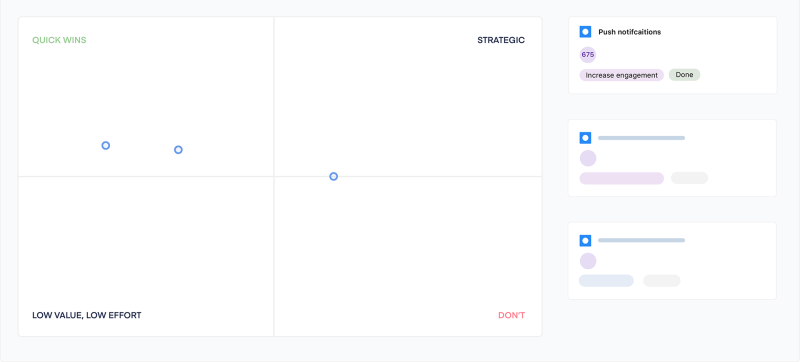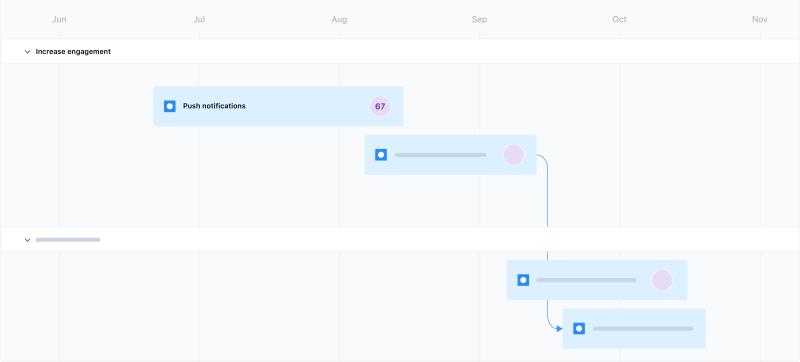
Prioritization is a key aspect of product and project management. And it’s something that becomes even more important in times of economic uncertainty. After all, knowing how to prioritize ensures that your resources are being utilized in the best, most efficient way possible. It also means that critical tasks are completed rather than pushed back.
But if you’ve ever felt that product prioritization is easier said than done, then you’re certainly not alone.
Everyone will have their own opinions and criteria for deciding how to prioritize tasks, which can lead to mistakes, arguments, and lost time.
That's where a solution prioritization matrix comes in — and the prioritization matrix templates that product teams can use to work even more efficiently.
What is a solution prioritization matrix?
A solution prioritization matrix is a tool used to help prioritize a large number of tasks. It can be used to determine which tasks to work on in product development, communicate high-value tasks to stakeholders, or increase collaboration among team members.
Generally, a prioritization matrix template will be made up of four quadrants. Each quadrant is then filled in with tasks or projects, with each quadrant designating the prioritization of the tasks/projects within it.

So how do you use a priority matrix? We'll explore this in more detail further on, but the basic idea is to vote on the priority of each task/project based on agreed-upon criteria. After the voting and discussions are finished, each task/project is mapped onto the matrix.
The strengths of a prioritization matrix
As you can probably see right away, there are several strengths that you benefit from when using a prioritization matrix. To help you better understand why it's a powerful tool to invest in, here are some of the key strengths supporting the agile prioritization matrix.
Quickly organize a large number of tasks
First, a product prioritization matrix makes it easy to organize a large number of tasks quickly. This is by far the biggest strength of this tool, and it's one of the key reasons that people adopt this strategy when organizing their product development timelines.
A prioritization matrix is a great tool for mapping large quantities of tasks in a visual, easy-to-grasp manner. You can look at any prioritization matrix template and — within seconds — understand what you're supposed to be working on, what's on the horizon, and what you probably aren't going to get around to unless all goes well.
Not to mention that this is a fast process. You can successfully organize all of your tasks using this kind of tool in one afternoon once you and your team get the hang of it.

There are many use cases for the prioritization matrix
Another reason that product managers love using prioritization matrices is that they are extremely versatile. The most obvious and perhaps most popular use case is organizing tasks associated with developing a product or completing a project.
However, you could start off each day at work by creating a prioritization matrix. You can determine which emails you're going to respond to first, decide if you'll handle emails before phone calls, can better structure your meetings, and so on.
The prioritization matrix template is such a simple, fundamental tool that the applications are nearly endless. Any time you have more than a few tasks that you're looking to prioritize, an agile prioritization matrix can be a helpful tool in doing so.
Easy to use and understand
The last major strength of a prioritization matrix is that it is easy to use and understand. Once you've had a bit of practice with it, you should be able to create a prioritization matrix in a matter of minutes. And if it's a more complex matrix, a few hours with your team should be enough time to complete it.
Once created, you can post the matrix somewhere that everyone on your team, including stakeholders, can view it. They'll be able to quickly see what you're working on, what is the highest priority for your team, and more.
It's an excellent tool for understanding what's most important to your team and why, as well as understanding the relationship between various tasks and projects.

The drawbacks of a prioritization matrix
Of course, as with anything, an agile prioritization matrix is not without its weaknesses.
It is worth pointing out that these are not flaws or mistakes of the template — but issues that can arise whenever you create a prioritization matrix. Knowing about them ahead of time is the best way to prevent these issues from cropping up.
You need to enforce neutrality
For a prioritization matrix template to work, everyone using it needs to be neutral. This means that all stakeholders must agree on the criteria used to evaluate the tasks — and agree to leave their egos, biases, and personal opinions at the door. Without neutrality, the matrix can be skewed and lead to incorrect decisions.
It’s all too easy for bias to take over when making a prioritization matrix. This is one of the reasons why it's important to use a prioritization matrix template with your team rather than on your own.
Working with a group is a great way to naturally counter biases that might otherwise seep into your matrix. Make sure that everyone knows you should be objective when assigning priorities to tasks.
This can lead to important, "low priority/profit" tasks being overlooked
Another challenge that can arise when creating a product prioritization matrix is that "low priority" or "low profit" tasks can end up being overlooked. These are tasks that are still important and vital to your project overall, but that might not appear that way on your matrix due to the criteria you've selected.
As such, it's important to analyze your prioritization matrix after it's been created to evaluate its accuracy. Are there any tasks that ended up near the bottom of your list that should really be closer to the top? Is there a criteria that you initially picked and only now realize isn't a good metric?
It can be disheartening to address these kinds of questions, as it might mean you need to start over and create a new matrix. However, as you become more practiced in creating matrices, you'll find yourself running into this problem less and less.
Might be too rigid for your team
Lastly, a prioritization matrix might be too rigid of a solution for your team. While it is versatile when it comes to the number of applications it has, the matrix template itself is, by design, fairly stiff.
The reason for this is to help you give structure to the tasks you need to complete and to better organize them based on their priority. However, your team might be more concerned with the order of operations than with priority. Or maybe the tasks you have to work on are so broad that prioritizing them creates an incomplete overview.
While this will likely become more clear after you've made a prioritization matrix, it can help to understand and evaluate whether or not this kind of matrix is right for your team early on. That way, you don't sink time or resources into a tool that isn't the right fit for your team's approach.

Use cases for a prioritization matrix template
Speaking of the versatility of a prioritization matrix, let's dive into some of the primary use cases it can cover. These are by no means comprehensive, though you'll likely find yourself using an agile prioritization matrix for one of the following purposes.
Determine what tasks to work on in product development
As we've covered for most of this article, a product prioritization matrix is great for determining what tasks to work on when developing a product. It can help you start with the most important, essential tasks first, then work your way down from there.
This is useful because it ensures that everything that needs to happen — and everything your stakeholders are requiring — is completed. Then, the extra details and polish, which aren't as essential, are addressed later. And if need be, they can be left off without harming your product too severely.
Communicate high-value tasks to your stakeholders
Another use for prioritization matrices is that they can help you communicate the importance of high-value tasks to your stakeholders. Oftentimes, there is a bit of a disconnect between what your team needs to work on and what your stakeholders' vision for the product/project is.
A prioritization matrix can be a great tool for aligning your visions. It can put things into perspective for your stakeholders while also giving them a chance to provide valuable input. This ensures that nothing critical is skipped, as everyone has had a chance to clearly see where your priorities are at.

Increase collaboration among your team
One of the most potent use cases for a prioritization matrix is increasing collaboration among your team. Like most agile tools, it requires you to sit with your team and talk about the "meta" of your product.
It's easy to fall into the trap of only talking to your team members whenever you have a problem or question that needs answering. Creating a prioritization matrix can help break you out of this trap and give everyone a chance to talk, share their opinions, and learn from one another.

How to use a prioritization matrix template
Now that you know what a prioritization matrix is, are familiar with its strengths and weaknesses, and have an idea of when to use it (and when not to) let's explore how actually use a strategy prioritization matrix.
Below are the specific steps involved in using a prioritization matrix template.
Make a list of tasks, projects, etc.
The first step in using a prioritization matrix template happens before you actually start using the template. That step is creating a list of the tasks, projects, or whatever it is you're prioritizing.
You want to be thorough, so try to list every task that might come up in a project. It's up to you if you want to categorize "tasks" as everything that needs to be done, features that need to be created, and/or general steps in the production process.
Create/Choose your prioritization matrix template
Next, you'll want to choose or create your own prioritization matrix template. Starting from scratch is a good idea if you need a customized solution. However, for most, working from a template will be ideal. There are even tools available that you can choose from, but we'll cover that more in a bit.
When choosing a template, look for one that matches your needs and, ideally, offers interactive features to boot. Software templates are a great option.
Vote on and discuss the prioritization of each task
Once you've listed out all of the tasks, it's time to discuss the prioritization of these tasks with your team. Each person can cast their vote on how to prioritize each task, after which you can create an average score for each task.
Map each task to the prioritization matrix
Lastly, it's time to map each task to your prioritization matrix template. You can do this by looking at the score that you've given to each of the tasks as well as comparing them to the criteria that you've established with your team.
How to create a prioritization matrix
If you want to build a prioritization matrix from scratch, you will need to create a list of tasks, projects, etc. that you want to prioritize.
Next, you will need to decide on a method for ranking the tasks. Once you have a ranking system, you can start to fill in the matrix.
That said, we recommend working from a prioritization matrix template. There a plenty of options online, including a free interactive option that is included with airfocus.
FAQs
Q1: What is a prioritization matrix?
A1: A prioritization matrix is a tool used to prioritize projects or tasks based on factors such as importance and urgency. This can help teams or individuals decide which tasks to complete first, which is useful when working on a long-term or complicated project.
Q2: Who should use a prioritization matrix template?
A2: A prioritization matrix template can be used by individuals or teams when there are multiple tasks or projects that need to be completed. The wide array of situations in which a prioritization matrix is useful is one of the reasons it is such a powerful tool.
Q3: How do you create a prioritization matrix in Excel?
A3: You can create a prioritization matrix in Excel, start from a template, or by using an interactive tool. Using an interactive tool is generally recommended, though any of these routes can lead to an effective and useful prioritization matrix.

Tomas Prochazka

Read also



Prioritize with confidence

Experience the new way of doing product management



